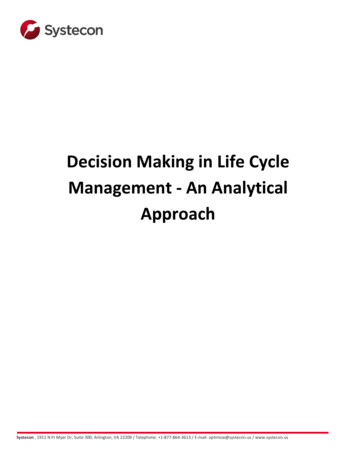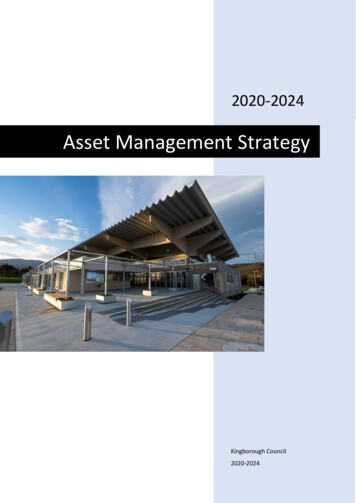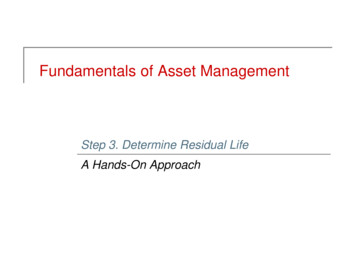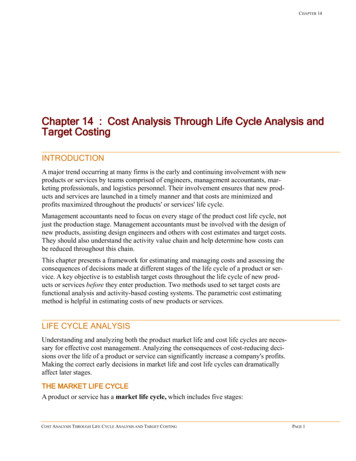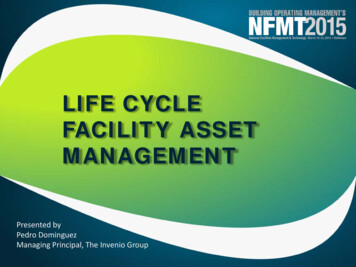
Transcription
LIFE CYCLEFACILITY ASSETMANAGEMENTPresented byPedro DominguezManaging Principal, The Invenio Group
LEARNING OBJECTIVES Correlate the current business environment to thedemands placed on facility managers Assess how decisions made throughout the facility lifecycle impact value Identify gaps in their maintenance managementprocesses Determine the strategy for implementing a risk-basedapproach that will address those gaps
AGENDA Current business environmentLife cycle facility asset managementChanging world of maintenance managementRisk-based reliability approach
BUSINESS ENVIRONMENT Aging facility assets Financial pressures Emergency preparation Information management Personnel management Evolving skill sets
AGING FACILITY ASSETSKey Issues: Deferred maintenance Facility end-of-life decisions Customer satisfactionDemands on Facility Managers: Utilization of facility condition assessment Manage maintenance backlog Life-cycle management Reduce Cost to Maintain
FINANCIAL PRESSURESKey Issues: Outsourcing may not reduce costs Routine maintenance requires effortDemands on Facility Managers: Reduce Cost to Maintain Satisfy operating expectations Manage maintenance without supporting data Creating value from physical assets
INFORMATION MANAGEMENTKey Issues: Datao complexityo quantityo usability Industry standardsDemands on Facility Managers: Proactive data management Decision-making support Documentation management Off-peak operations capabilities
EMERGENCY PREPARATIONKey Issues: Focuso personnel safetyo business disruptiono supply chain disruptiono recovery Facility self-relianceDemands on Facility Managers: Analyze vulnerabilities Develop risk mitigation strategies maintenance of protective systems business recovery and continuity on-site presence
PERSONNEL MANAGEMENTKey Issues: Marketingo Brandingo outreach Business caseDemands on Facility Managers: Competency-based models Difficulty in recruiting Career path
EVOLVING SKILL SETSKey Issues: Technical knowledge Business acumen Human factorsDemands on Facility Managers: Assess current capabilities of corecompetencies Develop management and leadership skills Learn best practices Improve presentation skills
INDUSTRY CHALLENGESCommercial Buildings Business pressures Performing as stable, liquid assets Adapting to changing, shorter businesscycles Design and construction Growing demand for green, highperformance properties LEED requirements for new constructionand substantial renovations Energy: small improvements, large impact ADA: significant changes
INDUSTRY CHALLENGESTourism, Hospitality & Leisure Short term: less spending Fewer funds for consumers’discretionary spending Corporate cost-cuttingmeasures Longer view: capitalize onopportunities Human connection/ interactionremains important Innovative, cost-effectiveprograms can increasecustomer loyalty and drivedemand
INDUSTRY CHALLENGESLife Sciences Patient life drivers Manufacturing not a core business driver R&D and Marketing High pressure production start-up High profitability during patient life Sustainability Long validation times and high cost Inflexibility for continuous improvement Underutilization of automation andinformation
INDUSTRY CHALLENGESHealthcare Capital requirements for facility andtechnology needs Increased costs of borrowing Decreased access to financing Financial health is worsening Patients seek less care Investment gains turn to losses Hospitals and health care are critical tothe economy 2007: Health sector accounts for 45 %of new private sector jobs Hospitals employ more than 5 millionpeople Safety and Security compliance ITM (Inspection, testing,maintenance)o Program complianceo Protective systemso Documentation Housekeeping Storage
FACILITY LIFE CYCLETimeline10 yearsCommissioningFunctionalRequirements Owner User Architectural Engineering RegulatoryUtilizationFailure Causes Bad design Faulty constructions Normal wear & tear Environment Misuse Random failures20 years30 yearsFailure Management Decisions?Facility Impact Costs Value Safety Environmental Compliance OccupancyMaintenance Predictive Preventive DetectiveRestore/Rebuild/Replace Equipment Infrastructure TechnologyCOMPANY STRATEGY FOR ASSET MANAGEMENT( POLICY, STRATEGY, OBJECTIVES, PLANS)
FACILITY LIFE CYCLEMaximizing value through theFacility Life CycleProcessesResourcesVALUE CommissionOperateMaturityVALUEPRESERVATION16
FACILITY LIFE CYCLEDECISIONS ANDOPPORTUNITIES Strategy: Misalignment between critical projectstakeholders (owners, architects, engineers contractors,operations & maintenance) Design: User requirements not validated Maintenance: Antiquated maintenance strategies basedlargely on OEM recommendations, typically time‐based PMwith heavy reliance on parts replacements Information: High volume of operations and maintenanceinformation in disparate formats Personnel: Operators and maintainers unprepared withnecessary knowledge and skills Asset protection: Protective systems plans not defined
MAINTENANCE STRATEGYThe Changing Scope of User Expectations3rd Generation2nd Generation1st Generation Fix it when itbreaks Increasedavailability Cost reduction Longer asset life Greater reliability Cost-effectiveness Reduced risk
MAINTENANCE STRATEGYThe Changing Environment Scope of user expectations Better understanding of why assets fail Changing paradigms Varied and complex equipment New technologies and techniques Information management
MAINTENANCE STRATEGYBetter understanding ofEquipment FailureAsset Failure Patterns4%AAgeBathtubB2%Age Constant, ending with wear out zone5%CAgeSlowly increasingAgeRapid increaseDEAgeRandomAgeInfant mortality to randomFIndustry DataEquipment withdominant failure modes, 11 % Age-related normally subject to:- direct product contact- fatigue- corrosion- abrasion7%14 %68 % 89 %RandomComplex equipment:- electronics- pneumatics- hydraulics
MAINTENANCE STRATEGYBetter understanding ofEquipment FailureBefore assets enter service .Asset delivery process:Incorrect specificationsImproperly designedImproperly builtWrong equipment deliveredAsset commissioning process:Improper installationInadequate spares policiesAfter assets enter service Assets lose capability:Equipment-related (mechanical, electrical, hydraulic)Inadequate process conditions (temperature, pressure)Inadequate process inputs (raw materials, energy, utilities)Inadequate work methods (maintenance/cleaning/operations/quality)Asset capability exceeded:Demand and goals increasedEquipment overloadedIncorrect capacity planning
MAINTENANCE STRATEGYChanging ParadigmsOld paradigms Maintain equipment Minimize failures Preventive maintenance Maintenance department focusNew paradigms Preserve functions Minimize risk Proactive Maintenance Multidisciplinary team focus
MAINTENANCE STRATEGYInformation ManagementKey Issues: Right information Technical Operational Historical Financial Managed information Availability Completeness Usability Documentation Physical Digital Access
MAINTENANCE STRATEGYThe Maintenance ProcessAsset Information Hierarchal list Owners & responsibilities Documentation History Condition & StatusOptimization Reporting Performance gap analysis Resource Management Improvement program Protective systemsStrategy Organizational alignment Criticality & prioritization Risk Management Reliability Program Management of ChangeWork Management Work identification Reactive work Planning & Scheduling Execution & Follow-up
MAINTENANCE PROCESSGap Assessment:Asset InformationACTIVITY/SCOPEListing and HierarchyOwners andResponsibilitiesDocumentationCondition & StatusHistorySTATUSBUSINESS RISKBEST PRACTICE
MAINTENANCE PROCESSGap Assessment:StrategyACTIVITY/SCOPEBusiness StrategyAlignmentCriticality/PrioritizationRisk ManagementReliability ProgramManagement ofChangeSTATUSBUSINESS RISKBEST PRACTICE
MAINTENANCE PROCESSGap Assessment:Work ManagementACTIVITY/SCOPEProactive WorkidentificationReactive workidentificationPlanning & SchedulingExecution & follow-upSTATUSBUSINESS RISKBEST PRACTICE
MAINTENANCE PROCESSGap Assessment:OptimizationACTIVITY/SCOPEWork ReportingPerformance analysisResource managementImprovement ProgramManagement ofProtective SystemsSTATUSBUSINESS RISKBEST PRACTICE
RISK MANAGEMENTManaging the Risk toBusiness Operations Systemic processes to co-ordinate, facilitate and improvedecision-making with respect to risk Provides stakeholders with greater assurance of a company’sability to deal with potential risk Applicable to all types of business processes Facility planning & forecasting Architectural/Engineering design Construction management Commissioning Operations Maintenance Emergency preparation
RISK MANAGEMENTWhat is the acceptable risk?Who should decide?
RISK MANAGEMENTPerception, acceptance and tolerance of risk isfrom the perspective of the stakeholder Medical practitionersPatientsEmployeesCompanies IndustryGovernmentHealth care organizationsSocietyRisk has two components: Probability of occurrence of a harm Severity (consequences) of a harmRisk Management is subjective because each stakeholder has adifferent viewpoint of probability and severity
RISK MANAGEMENTRisk PolicySeverity LevelCriticalHighSeverity of Harm1 : BusinessSeverity of Harm1 :GovernanceSeverity of Harm1 to OperationsDefinitionDefinitionDefinition Moderate Low Negligible Extended international media coverageUnrecoverable market share lossExtended business disruptionOne-time international media coverageRecoverable market share lossShort-term business disruptionExtended local media coverageMarket share erosionLocal business disruptionOne-time local media coverageLimited market share erosionLocal business disruptionNo media coverageNo market share lossNo business disruptionOutput: Not recoverableOperating Costs: Customer Service: LossOutput: RecoverableOperating Costs: Customer Service: ComplaintOutput: Excess capacityOperating Costs: Customer Service: Repeated late deliveryOutput: Buffer inventoryOperating Costs: Customer Service: Late deliveryOutput: Downtime onlyOperating Costs: Customer Service: Not affected
RISK MANAGEMENTRisk PolicyProbability of Harm2Probability urrence Per Test 4 in 20 Business Operations 15%3 in 20 Business Operations 10 to 15%2 in 20 Business Operations 5 to 10%1 in 20 Business Operations 1 to 5% 1 in 100 Business Operations 1%
RISK MANAGEMENTRisk Policy:Standard Matrix 5x5RISK EVALUATION MATRIXHARM PROBABILTY LEVELSHARM SEVERITY hicFrequentP5 S1P5 S2P5 S3P5 S4P5 S54ProbableP4 S1P4 S2P4 S3P4 S4P4 S53OccasionalP3 S1P3 S2P3 S3P3 S4P3 S52RemoteP2 S1P2 S2P2 S3P2 S4P2 S51ImprobableP1 S1P1 S2P1 S3P1 S4P1 S5RATINGDESCRIPTION5RISKREQUIRED ACTIONSUnacceptable RiskRisk Reduction RequiredRisk May be Acceptable / TolerableInvestigate Risk ReductionAcceptableNo Risk Reduction Required
RISK MANAGEMENTRisk ManagementApproaches Quantitative Requires high-quality data Assigns numerical value to indices Reduces uncertainty Time-consuming May require specialized tools and software Qualitative Requires experience Assigns interval scales to indices More subjective Quick and easier No specialized tools
RISK MANAGEMENTRisk ManagementApproaches Qualitative Processes Event trees Failure Cause Mapping FMEA Process mapping Hazard and Operability Study (HAZOPS) Preliminary Hazards Analysis (PHA) Human Factors Analysis TRIZ (Theory of Inventive Problem Solving) Qualitative Processes Probabilistic Risk Assessment (PRA) Monte Carlo simulation Reliability Availability Model What-if analysis
RISK MANAGEMENT Core Elements Risk Management Policy Risk Management Plan Risk Assessment Solution implementation Continuous improvement Standards ISO OSHA ANSI NFPA Outputs Process improvements SOPs Employee training
RISK MANAGEMENTRisk AssessmentINFORMATION WORKSHEETFUNCTIONWhat do we wantthis facility to do? Buildingenvelope HVAC Electrical Plumbing Illumination Infrastructure TransportFUNCTIONALFAILUREHow can thisfunction fail? Owners Managers UsersFAILURE MODEFAILURE CAUSEFAILURE EFFECT1st level failure: Environment Material Method HumanResources Equipment1st level failure isdue to: Actions ConditionsEvidenceImpact Safety Environment Operations RepairResolution
RISK MANAGEMENTRisk AssessmentRISK MITIGATION WORKSHEETRISK ANALYSISSeverity Governance Financial Safety Environment Compliance Operations Repair costsProbability High Medium LowCURRENTCONTROLSWhat do we havein place to affectrisk? Business Process DetectionUNMITIGATEDRISKEVALUATIONRisk Guidance Acceptable Tolerable UnacceptableMITIGATIONDECISIONS Inspections PredictiveMaintenance PreventiveMaintenance Corrective action Redesign: Procedures andTrainingUNMITIGATEDRISKEVALUATIONRisk Guidance Acceptable Tolerable Unacceptable
RISK MANAGEMENTProtective Systems In the ideal world, all facility assets- manufacturing, utilities andfacilities – would operate in a stable environment with normalconditions. In the real world, the equipment is subject to abnormalconditions that could produce a scenario which threatens thefacilities, affects the product, compromises security or threatenshuman lives and the environment.
RISK MANAGEMENTProtective SystemsProtective systems arenecessary to avoid or mitigatethe consequences ofabnormal conditions placedon equipment.Designers have incorporatedfeatures on equipment to improveconfidence that we are wellprotected in the unlikely eventthat the abnormal conditionactually occurs.But, what if the protection fails?We still need to manage protective systems to minimize the personaland business risk associated with their failures.
RISK MANAGEMENTProtective SystemsCategories of protective systems: Warn of abnormal conditionsShutdown equipment and processes in the event of anabnormal conditionEliminate or relieve abnormal conditionsTake-over when other equipment has failedPrevent dangerous situations from occurring in the event ofan abnormal condition
RISK MANAGEMENTProtective SystemsProtective Systems can fail in two ways: By not providing protection when neededIn the worst case, this could produce a scenario which destroys theequipment or facilities, contaminates the product or threatenshuman lives and the environment. By acting when they are not neededIn the best case, this results in a nuisance interruption in theoperation of the equipment.
RISK MANAGEMENTProtective SystemsFor many facility operations, up to 50% of the failures areprotective systems.Their functions and failures are not clearly understood.The vast majority of these systems require proactive interventionto reduce the risk.Existing maintenance programs do not manage these systemsadequately: Less than 1/3 of these systems are maintained at all (usually atthe wrong interval) Another 1/3 receive no attention, although their existence isknown by operations and maintenance The existence of the final 1/3 is not known
RISK MANAGEMENTSummaryA successful Facility LifecycleManagement Programdepends on a vision thatmerges people, place,purpose and technology.Design value addingprocesses to meet serviceslevels & organizationrequirementsOrganizations that are willingto address these issues cantransform their business tomeet the current challengessuccessfully and reducebusiness riskDetermine requirements tosupport processes: Information technologies Personnel selection & development Asset data collection Documentation organization
RISK MANAGEMENTContact InformationPedro DominguezThe Invenio Groupwww.inveniogrp.compedrofd@inveniogrp.com(443) 838-1958
Life-cycle management Reduce Cost to Maintain AGING FACILITY ASSETS . Demands on Facility Managers : Reduce Cost to Maintain . Performance gap analysis Resource Management Improvement program Protective systems . Gap Assessment: Asset Information . MAINTENANCE PROCESS .


